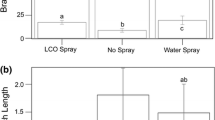Abstract
Lepidimoide promotes growth of the cockscomb hypocotyl. It is exuded from germinating seeds of various plant species into their culture environment. The mode of exudation of lepidimoide from seeds into the culture solution, using sunflower and buckwheat seeds, was studied in relation to seed germination. In the dry seeds, about 75% of the lepidimoide was found in the seed coat and about 25% in the kernel. Upon water imbibition it was released into the culture solution. However, the quantity of lepidimoide detected in the seed exudate was more than three times the total amount in dry and imbibed seeds, suggesting that lepidimoide was also produced de novo in the seeds and subsequently released. When seed coats or kernels were imbibed separately, the quantity of lepidimoide released from the seed coats into the culture solution was much the same as that in the dry seeds, but the amount of lepidimoide detected in the exudate of kernels was about 16 times that in the dry kernels. These results suggest that lepidimoide, already present in dry seeds, as well as that newly produced in the kernels following imbibition, was released into the environment.
Similar content being viewed by others
References
Fry CS, Aldington S, Hetherington PR and Aitken J (1993) Oligosaccharides as signals and substrates in the plant cell wall. Plant Physiol 103: 1–5
Goto N, Sando S, Sato Y and Hasegawa K (1995) Effects of lepidimoide on growth and development of Arabidopsis thaliana. Weed Res Japan 40: 87–94
Hasegawa K, Amano M and Mizutani J (1992) Allelopathic substances produced from cress seedlings. Weed Res Japan (in Japanese) 37: 71–73
Hasegawa K, Mizutani J, Kosemura S and Yamamura S (1992) Isolation and identification of lepidimoide, a new allelopathic substance from mucilage of germinated cress seeds. Plant Physiol 100: 1059–1061
Kosemura S, Yamamura S, Kakuta H, Mizutani J and Hasegawa K (1993) Synthesis and absolute configuration of lepidimoide, a high potent allelopathic substance from mucilage of germinated cress seeds. Tetrahedron Lett 34: 2653–2656
Miyamoto K, Ueda J, Yamada K, Kosemura S, Yamamura S and Hasegawa K (1997) Inhibitory effect of lepidimoide on senescence in Avena leaf segments. J Plant Physiol 150: 133–136
Miyamoto K, Ueda J, Yamada K, Kosemura S, Yamamura S and Hasegawa K (1997) Inhibition of abscission of bean petiole explants by lepidimoide. J Plant Growth Regulation 16: 7–9
Molisch H (1937) Der Einfluss einer Pflanze auf die andere-Allelopathie. Jena: Gustav Fischer Verlag
Yamada K, Anai T and Hasegawa K (1995) Lepidimoide, an allelopathic substance in the exudates from germinated seeds. Phytochemistry 39: 1031–1032
Yamada K, Anai T, Kosemura S, Yamamura S and Hasegawa K (1996) Structure-activity relationship of lepidimoide and its analogues. Phytochemistry 41: 671–673
Author information
Authors and Affiliations
Rights and permissions
About this article
Cite this article
Yamada, K., Kosemura, S., Yamamura, S. et al. Exudation of an allelopathic substance lepidimoide from seeds during germination. Plant Growth Regulation 22, 189–192 (1997). https://doi.org/10.1023/A:1005885218610
Issue Date:
DOI: https://doi.org/10.1023/A:1005885218610




